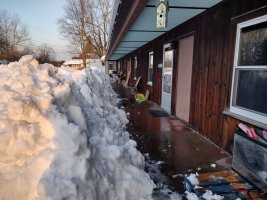SageHill
Herd Master
HOLY MOLY!!! That's a blankety blanket of snow. YIKES.
So sorry about your fence - that hurts.
Out here I have 2x4 woven no-climb. Pulled super tight using a bobcat, top and bottom wires and metal bars as well, extra fence posts metal tube 3 in? set in concrete and cross braced, the rest are T-posts. Though we don't get snow ever - I see it only on the mountaintops when it happens (very pretty when framed in palm trees).
So sorry about your fence - that hurts.
Out here I have 2x4 woven no-climb. Pulled super tight using a bobcat, top and bottom wires and metal bars as well, extra fence posts metal tube 3 in? set in concrete and cross braced, the rest are T-posts. Though we don't get snow ever - I see it only on the mountaintops when it happens (very pretty when framed in palm trees).

 Until this storm, they were in JUST electric (although its FIVE strands, closely spaced and BITEY). So we will definitely be using both. I'll definitely plan for a lot of extra wood posts in the perimeter fence... maybe we will just do all wood. It's already gonna take forever to get it done. What's an extra year of saving at this point?
Until this storm, they were in JUST electric (although its FIVE strands, closely spaced and BITEY). So we will definitely be using both. I'll definitely plan for a lot of extra wood posts in the perimeter fence... maybe we will just do all wood. It's already gonna take forever to get it done. What's an extra year of saving at this point? 




